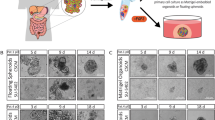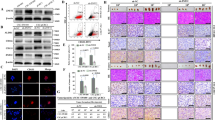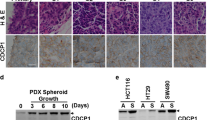Abstract
NANOG is a stem cell transcription factor that is essential for embryonic development, reprogramming normal adult cells and malignant transformation and progression. The nearly identical retrogene NANOGP8 is expressed in multiple cancers, but generally not in normal tissues and its function is not well defined. Our postulate is that NANOGP8 directly modulates the stemness of individual human colorectal carcinoma (CRC) cells. Stemness was measured in vitro as the spherogenicity of single CRC cells in serum-free medium and the size of the side population (SP) and in vivo as tumorigenicity and experimental metastatic potential in NOD/SCID mice. We found that 80% of clinical liver metastases express a NANOG with 75% of the positive metastases containing NANOGP8 transcripts. In all, 3–62% of single cells within six CRC lines form spheroids in serum-free medium in suspension. NANOGP8 is translated into protein. The relative expression of a NANOG gene increased 8- to 122-fold during spheroid formation, more than the increase in OCT4 or SOX2 transcripts with NANOGP8 the more prevalent family member. Short hairpin RNA (shRNA) to NANOG not only inhibits spherogenicity but also reduces expression of OCT4 and SOX2, the size of the SP and tumor growth in vivo. Inhibition of NANOG gene expression is associated with inhibition of proliferation and decreased phosphorylation of G2-related cell-cycle proteins. Overexpression of NANOGP8 rescues single-cell spherogenicity when NANOG gene expression is inhibited and increases the SP in CRC. Thus, NANOGP8 can substitute for NANOG in directly promoting stemness in CRC.
This is a preview of subscription content, access via your institution
Access options
Subscribe to this journal
Receive 50 print issues and online access
$259.00 per year
only $5.18 per issue
Buy this article
- Purchase on Springer Link
- Instant access to full article PDF
Prices may be subject to local taxes which are calculated during checkout






Similar content being viewed by others
References
Takahashi K, Yamanaka S . Induction of pluripotent stem cells from mouse embryonic and adult fibroblast cultures by defined factors. Cell 2006; 126: 663–676.
Takahashi K, Tanabe K, Ohnuki M, Narita M, Ichisaka T, Tomoda K et al. Induction of pluripotent stem cells from adult human fibroblasts by defined factors. Cell 2007; 131: 861–872.
Yu J, Hu K, Smuga-Otto K, Tian S, Stewart R, Slukvin II et al. Human induced pluripotent stem cells free of vector and transgene sequences. Science 2009; 324: 797–801.
Park IH, Arora N, Huo H, Maherali N, Ahfeldt T, Shimamura A et al. Disease-specific induced pluripotent stem cells. Cell 2008; 134: 877–886.
Miyoshi N, Ishii H, Nagai K, Hoshino H, Mimori K, Tanaka F et al. Defined factors induce reprogramming of gastrointestinal cancer cells. Proc Natl Acad Sci USA 2010; 107: 40–45.
Silva J, Nichols J, Theunissen TW, Guo G, van Oosten AL, Barrandon O et al. NANOG is the gateway to the pluripotent ground state. Cell 2009; 138: 722–737.
Mitsui K, Tokuzawa Y, Itoh H, Segawa K, Murakami M, Takahashi K et al. The homeoprotein NANOG is required for maintenance of pluripotency in mouse epiblast and ES cells. Cell 2003; 113: 631–642.
Chambers I, Silva J, Colby D, Nichols J, Nijmeijer B, Robertson M et al. NANOG safeguards pluripotency and mediates germline development. Nature 2007; 450: 1230–1234.
Lengner CJ, Camargo FD, Hochedlinger K, Welstead GG, Zaidi S, Gokhale S et al. Oct4 expression is not required for mouse somatic stem cell self-renewal. Cell Stem Cell 2007; 1: 403–415.
Utikal J, Maherali N, Kulalert W, Hochedlinger K . Sox2 is dispensable for the reprogramming of melanocytes and melanoma cells into induced pluripotent stem cells. J Cell Sci 2009; 122: 3502–3510.
Miyanari Y, Torres-Padilla ME . Control of ground-state pluripotency by allelic regulation of NANOG. Nature 2012; 483: 470–473.
Zhang J, Wang X, Li M, Han J, Chen B, Wang B et al. NANOGP8 is a retrogene expressed in cancers. FEBS J 2006; 273: 1723–1730.
Jeter CR, Badeaux M, Choy G, Chandra D, Patrawala L, Liu C et al. Functional evidence that the self-renewal gene NANOG regulates human tumor development. Stem Cells 2009; 27: 993–1005.
Jeter CR, Liu B, Liu X, Chen X, Liu C, Calhoun-Davis T et al. NANOG promotes cancer stem cell characteristics and prostate cancer resistance to androgen deprivation. Oncogene 2011; 30: 3833–3845.
Po A, Ferretti E, Miele E, Smaele ED, Paganelli A, Canettieri G et al. Hedgehog controls neural stem cells through p53-independent regulation of NANOG. EMBO J 2010; 29: 2646–2658.
Zbinden M, Duquet A, Lorente-Trigos A, Ngwabyt SN, Borges I, Ruiz i Altaba A . NANOG regulates glioma stem cells and is essential in vivo acting in a cross-functional network with GLI1 and p53. EMBO J 2010; 29: 2659–2674.
Saiki Y, Ishimaru S, Mimori K, Takatsuno Y, Nagahara M, Ishii H et al. Comprehensive analysis of the clinical significance of inducing pluripotent stemness-related gene expression in colorectal cancer cells. Ann Surg Oncol 2009; 16: 2638–2644.
Meng HM, Zheng P, Wang XY, Liu C, Sui HM, Wu SJ et al. Overexpression of NANOG predicts tumor progression and poor prognosis in colorectal cancer. Cancer Biol Ther 2010; 9: 295–302.
Ishiguro T, Sato A, Ohata H, Sakai H, Nakagama H, Okamoto K . Differential expression of NANOG1 and NANOGp8 in colon cancer cells. Biochem Biophys Res Commun 2012; 418: 199–204.
Xu F, Dai C, Zhang R, Zhao Y, Peng S, Jia C . NANOG: a potential biomarker for liver metastasis of colorectal cancer. Dig Dis Sci 2012; 57: 2340–2346.
Eberle I, Pless B, Braun M, Dingermann T, Marschalek R . Transcriptional properties of human NANOG1 and NANOG2 in acute leukemic cells. Nucleic Acids Res 2010; 38: 5384–5395.
Mulder JW, Kruyt PM, Sewnath M, Oosting J, Seldenrijk CA, Weidema WF et al. Colorectal cancer prognosis and expression of exon-v6-containing CD44 proteins. Lancet 1994; 344: 1470–1472.
Booth HA, Holland PW . Eleven daughters of NANOG. Genomics 2004; 84: 229–238.
Ambady S, Malcuit C, Kashpur O, Kole D, Holmes WF, Hedblom E et al. Expression of NANOG and NANOGP8 in a variety of undifferentiated and differentiated human cells. Int J Dev Biol 2010; 54: 1743–1754.
Zhang J, Jessup JM, Thorgeirsson SS . NANOG family members are essential for spherogenicity and metastasis in colorectal carcinoma. In: Proceedings of the 102nd Annual Meeting of the American Association for Cancer Research; 2011. AACR, Orlando, Florida, Philadelphia (PA), 2011, Abstract 5206.
Jessup JM, Giavazzi R, Campbell D, Cleary KR, Morikawa K, Hostetter R et al. Metastatic potential of human colorectal carcinomas implanted into nude mice: prediction of clinical outcome in patients operated upon for cure. Cancer Res 1989; 49: 6906–6910.
Lu KP, Hanes SD, Hunter T . A human peptidyl-prolyl isomerase essential for regulation of mitosis. Nature 1996; 380: 544–547.
Nishi M, Akutsu H, Masui S, Kondo A, Nagashima Y, Kimura H et al. A distinct role for Pin1 in the induction and maintenance of pluripotency. J Biol Chem 2011; 286: 11593–11603.
Huang H, Qiao R, Zhao D, Zhang T, Li Y, Yi F et al. Profiling of mismatch discrimination in RNAi enabled rational design of allele-specific siRNAs. Nucleic Acids Res 2009; 37: 7560–7569.
Dykxhoorn DM, Schlehuber LD, London IM, Lieberman J . Determinants of specific RNA interference-mediated silencing of human beta-globin alleles differing by a single nucleotide polymorphism. Proc Natl Acad Sci USA 2006; 103: 5953–5958.
Goodell MA, Brose K, Paradis G, Conner AS, Mulligan RC . Isolation and functional properties of murine hematopoietic stem cells that are replicating in vivo. J Exp Med 1996; 183: 1797–1806.
Kumar SM, Liu S, Lu H, Zhang H, Zhang PJ, Gimotty PA et al. Acquired cancer stem cell phenotypes through Oct4-mediated dedifferentiation. Oncogene 2013; 31: 4898–4911.
Leis O, Eguiara A, Lopez-Arribillaga E, Alberdi MJ, Hernandez-Garcia S, Elorriaga K et al. Sox2 expression in breast tumours and activation in breast cancer stem cells. Oncogene 2012; 31: 1354–1365.
Boyer LA, Lee TI, Cole MF, Johnstone SE, Levine SS, Zucker JP et al. Core transcriptional regulatory circuitry in human embryonic stem cells. Cell 2005; 122: 947–956.
Chen X, Xu H, Yuan P, Fang F, Huss M, Vega VB et al. Integration of external signaling pathways with the core transcriptional network in embryonic stem cells. Cell 2008; 133: 1106–1117.
Kim J, Chu J, Shen X, Wang J, Orkin SH . An extended transcriptional network for pluripotency of embryonic stem cells. Cell 2008; 132: 1049–1061.
Ding J, Xu H, Faiola F, Ma’ayan A, Wang J . Oct4 links multiple epigenetic pathways to the pluripotency network. Cell Res 2012; 22: 155–167.
Sholl LM, Barletta JA, Yeap BY, Chirieac LR, Hornick JL . Sox2 protein expression is an independent poor prognostic indicator in stage I lung adenocarcinoma. Am J Surg Pathol 2010; 34: 1193–1198.
Bass AJ, Watanabe H, Mermel CH, Yu S, Perner S, Verhaak RG et al. SOX2 is an amplified lineage-survival oncogene in lung and esophageal squamous cell carcinomas. Nat Genet 2009; 41: 1238–1242.
Wang Q, He W, Lu C, Wang Z, Wang J, Giercksky KE et al. Oct3/4 and Sox2 are significantly associated with an unfavorable clinical outcome in human esophageal squamous cell carcinoma. Anticancer Res 2009; 29: 1233–1241.
Zhang J, Li YL, Zhou CY, Hu YT, Chen HZ . Expression of octamer-4 in serous and mucinous ovarian carcinoma. J Clin Pathol 2010; 63: 879–883.
Ji J, Zheng PS . Expression of Sox2 in human cervical carcinogenesis. Hum Pathol 2010; 41: 1438–1447.
Zhang X, Yu H, Yang Y, Zhu R, Bai J, Peng Z et al. SOX2 in gastric carcinoma, but not Hath1, is related to patients' clinicopathological features and prognosis. J Gastrointest Surg 2010; 14: 1220–1226.
You JS, Kang JK, Seo DW, Park JH, Park JW, Lee JC et al. Depletion of embryonic stem cell signature by histone deacetylase inhibitor in NCCIT cells: involvement of NANOG suppression. Cancer Res 2009; 69: 5716–5725.
Ben-Porath I, Thomson MW, Carey VJ, Ge R, Bell GW, Regev A et al. An embryonic stem cell-like gene expression signature in poorly differentiated aggressive human tumors. Nat Genet 2008; 40: 499–507.
Santagata S, Ligon KL, Hornick JL . Embryonic stem cell transcription factor signatures in the diagnosis of primary and metastatic germ cell tumors. Am J Surg Pathol 2007; 31: 836–845.
Katoh M . Network of WNT and other regulatory signaling cascades in pluripotent stem cells and cancer stem cells. Curr Pharm Biotechnol 2011; 12: 160–170.
Kong D, Banerjee S, Ahmad A, Li Y, Wang Z, Sethi S et al. Epithelial to mesenchymal transition is mechanistically linked with stem cell signatures in prostate cancer cells. PLoS One 2010; 5: e12445.
Salmena L, Poliseno L, Tay Y, Kats L, Pandolfi PP . A ceRNA hypothesis: the Rosetta Stone of a hidden RNA language? Cell 2011; 146: 353–358.
Chambers I, Colby D, Robertson M, Nichols J, Lee S, Tweedie S et al. Functional expression cloning of NANOG, a pluripotency sustaining factor in embryonic stem cells. Cell 2003; 113: 643–655.
Macfarlan TS, Gifford WD, Driscoll S, Lettieri K, Rowe HM, Bonanomi D et al. Embryonic stem cell potency fluctuates with endogenous retrovirus activity. Nature 2012; 487: 57–63.
Huang H, Regan KM, Lou Z, Chen J, Tindall DJ . CDK2-dependent phosphorylation of FOXO1 as an apoptotic response to DNA damage. Science 2006; 314: 294–297.
Zappone MV, Galli R, Catena R, Meani N, De Biasi S, Mattei E et al. Sox2 regulatory sequences direct expression of a (beta)-geo transgene to telencephalic neural stem cells and precursors of the mouse embryo, revealing regionalization of gene expression in CNS stem cells. Development 2000; 127: 2367–2382.
Lin KK, Goodell MA . Purification of hematopoietic stem cells using the side population. Methods Enzymol 2006; 420: 255–264.
Simkus C, Bhattacharyya A, Zhou M, Veenstra TD, Jones JM . Correlation between recombinase activating gene 1 ubiquitin ligase activity and V(D)J recombination. Immunology 2009; 128: 206–217.
Kinders RJ, Hollingshead M, Lawrence S, Ji J, Tabb B, Bonner WM et al. Development of a validated immunofluorescence assay for γH2AX as a pharmacodynamic marker of topoisomerase I inhibitor activity. Clin Cancer Res 2010; 16: 5447–5457.
Acknowledgements
We acknowledge the valuable advice and support of Drs Elizabeth Conner and Valentina Factor. Also, we gratefully acknowledge the support provided by the Center for Cancer Research of the NCI for Project ZIA BC 011199 and by the Department of Defense for Grant Number W81XWH-11-1-0327. The opinions expressed in this manuscript are those of the authors and do not necessarily represent those of the National Cancer Institute, the National Institutes of Health, the Department of Health and Human Services or the Department of the Army.
Author information
Authors and Affiliations
Corresponding author
Ethics declarations
Competing interests
The authors declare no conflict of interest.
Additional information
Supplementary Information accompanies the paper on the Oncogene website
Supplementary information
Rights and permissions
About this article
Cite this article
Zhang, J., Espinoza, L., Kinders, R. et al. NANOG modulates stemness in human colorectal cancer. Oncogene 32, 4397–4405 (2013). https://doi.org/10.1038/onc.2012.461
Received:
Revised:
Accepted:
Published:
Issue Date:
DOI: https://doi.org/10.1038/onc.2012.461
Keywords
This article is cited by
-
High NANOG expression correlates with worse patients’ survival in esophageal adenocarcinoma
BMC Cancer (2023)
-
Circular RNA ZNF800 (hsa_circ_0082096) regulates cancer stem cell properties and tumor growth in colorectal cancer
BMC Cancer (2023)
-
Restricting epigenetic activity promotes the reprogramming of transformed cells to pluripotency in a line-specific manner
Cell Death Discovery (2023)
-
Treatment with decitabine induces the expression of stemness markers, PD-L1 and NY-ESO-1 in colorectal cancer: potential for combined chemoimmunotherapy
Journal of Translational Medicine (2023)
-
Molecular targets and therapeutics in chemoresistance of triple-negative breast cancer
Medical Oncology (2022)



